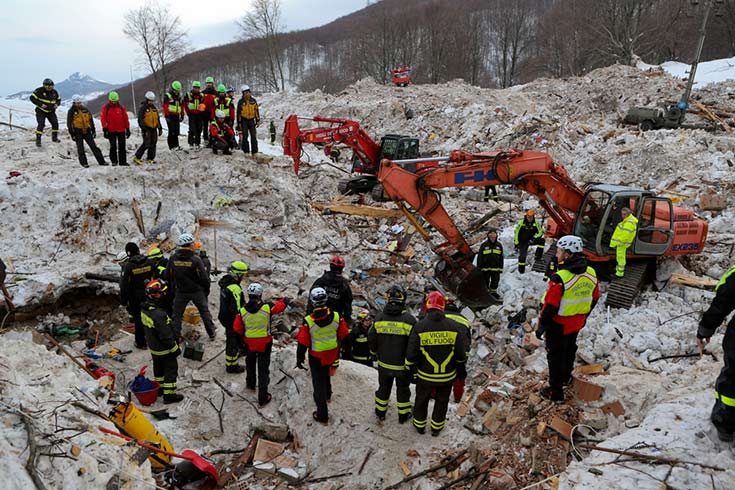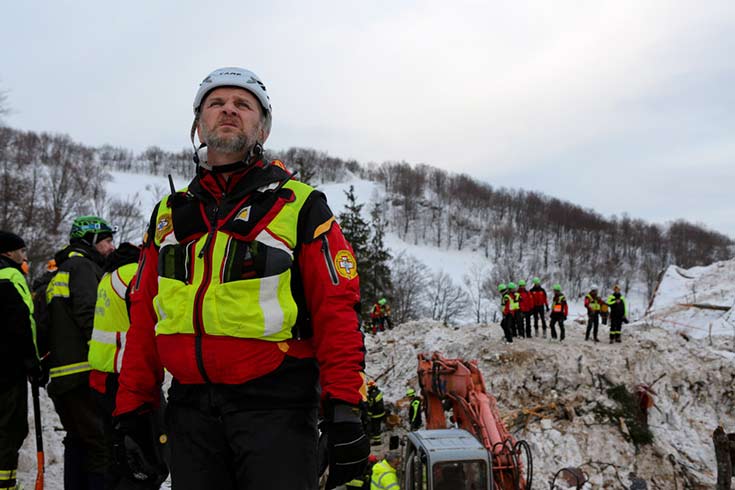An avoidable Alpine tragedy?
On the morning of Wednesday, January 19, 2017, the Abruzzo region of Central Italy was hit by four magnitude five earthquakes in quick succession, writes Martin Boyle, Editor of CRJ’s SAR blog.

The scene of the Rigopiano hotel after the avalance (photo: Website of the Italian Civil Protection Department – Presidency of the Council of Ministers)
Given recent heavy snowfall, the potential for avalanche after the seismic activity was high. Extreme weather conditions made it difficult for rescue teams to get to those areas that were hardest hit, none more so than the Rigopiano hotel in the Grand Sasso mountain range.
The hotel, a popular destination for celebrities, and described by former guests as a “relaxing refuge,” had been engulfed by a large avalanche, which struck as guests checked out and gathered on the ground floor in the early evening, awaiting the road to be cleared so they could be evacuated following the earthquakes.
https://youtu.be/OP1TXBM7i4Y
Forty people, including a number of children, were in the hotel when the avalanche struck. A guest who was by chance outside near his car raised the alarm, but it took repeated calls to emergency services before they believed that the hotel was under a mountain of snow and many people were trapped.
We can only imagine the survivor’s frustration mounting after being told by emergency services that the hotel was fine and had called in several hours earlier. This serves to remind us of the danger of working under assumptions with a lack of situational awareness in a rapidly changing operational environment.
It has emerged that it was not until two hours after the initial call was made that rescuers were deployed. Would an earlier response have made a difference to search and rescue efforts? That remains to be seen. There is also some conjecture as to whether or not the hotel should have been evacuated earlier, given the heavy snowfall and increased potential for avalanche. The matter will now be the subject of an official investigation.
The first response team of Alpine rescue specialists from the Guardia di Finanza faced an uphill battle in challenging conditions to reach the hotel using cross country skis to cover the final seven kilometres after coming to a halt at a road head blocked by trees and rocks.

Photo: Website of the Italian Civil Protection Department – Presidency of the Council of Ministers
The team arrived in the early hours of the morning, some 11 hours after the avalanche struck. They initially found two survivors who were sheltering in a car and a devastated hotel, which had been pushed a distance of more than 10 metres and was covered in some parts by several metres of snow according to media reports. After 24 hours of digging and searching still only two survivors had been found. Nine survivors were located in the first days of the rescue, including the wife and son of the guest who had first raised the alarm. His daughter was also later found and reunited with the family. No other survivors were found bringing the final the death toll to 29.
Almost exactly one year ago on January 12, 2016, Cervinia, a small town in the Italian Alps, had a close call when it was engulfed by an enormous cloud of powder snow. A 300-metre-wide slab avalanche broke off Juneaux Peak and raced down the steep slopes towards the resort, running out of momentum just short of the town. Luckily there were no injuries or damage to property. The local mayor was quoted as saying it was: “Too close for comfort”.
On Friday, January 27, 11 people were killed in a series of avalanches, the latest misfortune to befall the Kashmir region.
https://youtu.be/PvYeKjOFgKM
These events are not unprecedented, with tragedy from avalanches being reported throughout history. In 1970, in Yungay, Peru, a section of Mount Huascaran collapsed, and an avalanche of ice and snow ran nearly 11 miles, completely wiping out the town of Yungay and most of its 25,000 inhabitants. The village of Blons in Austria was also buried by an avalanche in 1954. A second avalanche hit the village as the rescue effort was underway resulting in over 200 deaths. And the list goes on…
How could towns, resorts and other infrastructure be better protected against avalanches? A new radar-based imaging system funded by the Engineering and Physical Sciences Research Council and developed by University College London, Durham and Sheffield University, together with the Swiss Federal Institute for Snow and Avalanche Research, could assist not only in developing an understanding of avalanche behavior but also in building better safeguards against them.
While traditional methods of controlled avalanche release using explosives are still widely used, a new radar avalanche detection system is being trialed in Zermatt this season. The system can monitor the early signs of avalanches on higher slopes and automatically close roads below (see video).
https://youtu.be/o-Z4Go9WdP0
The hope is that technology such as this could play an important part in safeguarding communities in alpine regions not only from avalanches but also rock and mudslides.
Martin Boyle
Martin Boyle, 31/01/2017